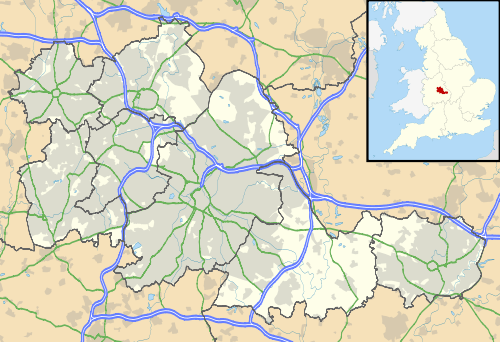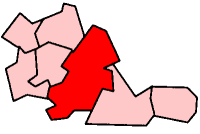Hall Green
| Hall Green | |
 Hall Green constituency shown within the city of Birmingham borough. |
|
 Independent businesses in a shopping area of Hall Green |
|
 Hall Green |
|
| Population | 26,429 (2001)[1] |
|---|---|
| – density | 4,867 per km² |
| OS grid reference | SP106815 |
| Metropolitan borough | Birmingham |
| Metropolitan county | West Midlands |
| Region | West Midlands |
| Country | England |
| Sovereign state | United Kingdom |
| Post town | BIRMINGHAM |
| Postcode district | B28 |
| Dialling code | 0121 |
| Police | West Midlands |
| Fire | West Midlands |
| Ambulance | West Midlands |
| EU Parliament | West Midlands |
| UK Parliament | Birmingham Hall Green |
|
|
Coordinates: 52°26′02″N 1°50′20″W / 52.434°N 1.839°W
Hall Green is an area in south-east Birmingham, England. It is also a council constituency, managed by its own district committee.
Politics
Hall Green is part of the parliamentary constituency of Birmingham, Hall Green, which also includes the wards of Moseley and Kings Heath, Sparkbrook and Springfield; the Member of Parliament for the constituency is Roger Godsiff, of the Labour Party. Hall Green ward is represented by three Labour councillors; Sam Burden (Hall Green's first elected Labour Councillor, elected in the 2011 May elections) with Barry Bowles (elected in May 2012) and is the Executive Member for Local Services Hall Green and Kerry Jenkins who was elected in May 2014 and is the Chair of the Hall Green Ward Committee.
Demographics
The 2001 Population Census found that there were 25,921 people living in Hall Green with a population density of 4,867 people per km², this compares with 3,649 people per km² for Birmingham. The population number has increased dramatically over the past decade according to recent surveys taken out. The percentage of population represented by whites used to be 74.6% and ethnic minorities used to be 25.4% . This number has changed drastically over the past 5 years with an increase of ethnic minorities.
Housing is largely inter-war. There is still a small number of independent locally run shops which survived the looting in the summer of 2011 (The August Riots).
Places of interest
There is a popular Greyhound racing stadium and race course situated on York Road called Hall Green Stadium. The stadium has won the BGRB Midlands and Western Region Racecourse of the Year 2003 award for the fourth consecutive year.
Hall Green was also home to Moor Green F.C., but the club is now known as Solihull Moors after a merger with Solihull Borough due to an arson attack by vandals in 2005 on the Moorlands stadium. [2]
The area is served by Hall Green Library, which was opened in 1962.[3]
The Shire Country Park runs past Sarehole Mill and along the course of the River Cole to Small Heath. Millstream Way passes through the park. Wildlife present at the country park include otters and water voles and many types of birds. The old village of Sarehole (now on the border of Hall Green and Moseley) is where J. R. R. Tolkien lived as a child and gained inspiration for the Hobbit's home "The Shire" as well as the book, "The Lord Of The Rings".
Architecture

On School Road is the Church of the Ascension, formerly the Job Marston Chapel, which was built in 1704 and is believed to have been designed by Sir William Wilson. The chancel and transepts were added in 1860. The brick building consists of an exterior with a stone entablature and balustrade supported by Doric pilasters and the window architraves are of moulded stone. At the west end is a tower with an octagonal upper storey with a copper cupola. The interior of the nave is covered by a coved plaster ceiling. It is the earliest classical church to survive within the city boundary.[4]
Other historic buildings in Hall Green include Sarehole Mill, one of only two watermills in the city.
Highfield House was another historical building. It was built in 1850, making it the oldest house and the third oldest building in Hall Green. It was the farm house for Highfield Farm. The house was built in Georgian style with beautiful Neo-Classical features. It also retained the original sash windows. In March 2008, in the face of much public opposition, petitions, articles in local newspapers and items on radio stations, Birmingham City Council's Planning Committee approved plans for its demolition and the building of four houses and six apartments.

As well as this is Petersfield Court, an Art Deco housing block containing 14 flats, built in 1937. Built out of brick, it has rounded corner windows, made possible by the introduction of reinforced concrete.[4] Later examples of architecture include the original Hall Green Technical College on the Stratford Road. It was designed by S. T. Walker and Partners in association with Alwyn Sheppard Fidler, the City architect for Birmingham. Built in 1958, it consists of a reinforced concrete framed classroom and an administration block clad with cedar boards and aluminium windows. Boarding was rarely used on educational buildings of this size at the time.[4]
A private development named "The Hamlet" was built between 1883 and 1893. It consists of fourteen villas on Hamlet and Fox Hollies Roads, along with the Friends Meeting House on the Stratford Road. The architectural style of these brick and tile properties is typified by massive chimneys and timbers, leaded casements, and bracketed bays. It is believed that initially all the properties carried a moulded plaque bearing the initials 'MS' along with the date of construction but few of these plaques now remain. Whilst there is not a definite explanation for the 'MS' monogram, the most likely interpretation is that they stand for Marian Severne whose families land they were built on.
Education
Primary schools in Hall Green include Chilcote Primary School, Hall Green Infant School, Hall Green Junior School, Lakey Lane Primary School, St Ambrose Barlow RC Primary School, Robin Hood Academy and Yorkmead School. Rosslyn School is an independent primary school located in the area.
Hall Green School is the main secondary school for the area, while South and City College Birmingham has a campus in Hall Green.
Transport
Hall Green railway station is on the Birmingham to Stratford Line. It opened in 1908.
Famous residents
Hall Green has been a home to comedian Tony Hancock, who lived at 41 Southam Road until the age of three (the house contains a plaque commemorating this), racing commentator Murray Walker, who was born at 214 Reddings Lane (which is now a dentist), Nigel Mansell, who though born in Upton-upon-Severn spent most of his childhood and early adult years in the area, comedian Joe Lycett, and most famously J. R. R. Tolkien, who lived near Sarehole Mill, Birmingham's only working water mill. Sarehole Mill is a tourist attraction, powered by the River Cole, that is open to visitors during the summer months and has several locations nearby that are the inspiration behind scenes in The Hobbit and The Lord of the Rings.
References
- ↑ "Birmingham Ward population 2011". Retrieved 14 December 2015.
- ↑ "Football club hit by arson attack". BBC News. 2005-01-27. Retrieved 2007-08-21.
- ↑ Rolf Weitzel (1962). Notes on the History of the Birmingham Public Libraries. Birmingham Public Libraries. p. 13.
- 1 2 3 Douglas Hickman (1970). Birmingham. Studio Vista Limited.
Further reading
- J R R Tolkien - A Biography, Humphrey Carpenter ISBN 0-261-10245-1
External links
- Hall Green Neighbourhood Forum
- Birmingham City Council: Hall Green Constituency
- Birmingham City Council: Hall Green Ward
- Greyhound racing in Hall Green
- Made in Birmingham
- Moor Green FC
- Hall Green School
- Yorkmead Primary School

